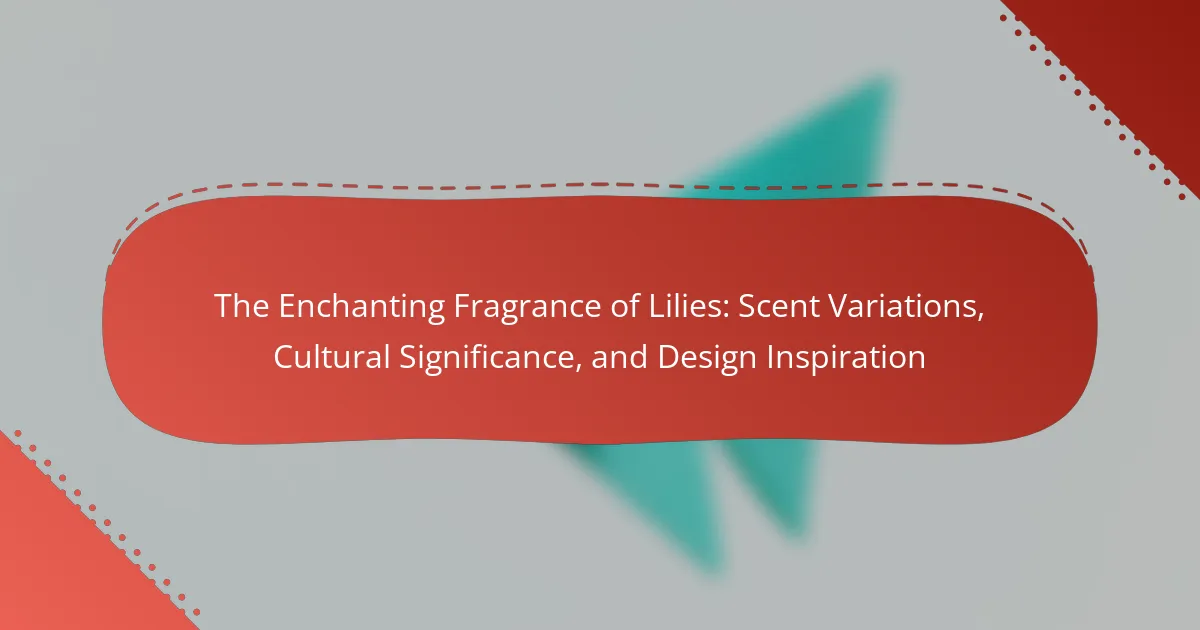
What are the enchanting fragrances of lilies?
Lilies have enchanting fragrances that vary among different species. The Oriental lily emits a strong, sweet scent, often described as intoxicating. The Asiatic lily has a more subtle, fresh fragrance that is less pronounced. Calla lilies, while not as fragrant, offer a light, sweet aroma. The trumpet lily is known for its powerful, citrus-like scent. These fragrances are often used in perfumes and floral arrangements. The distinct scents contribute to their popularity in gardens and floral displays. Research indicates that the fragrance of lilies can evoke emotions and memories, enhancing their appeal.
How do different lily varieties contribute to fragrance diversity?
Different lily varieties contribute to fragrance diversity through their unique scent profiles. Each variety possesses distinct aromatic compounds. For instance, Oriental lilies are known for their strong, sweet fragrances. In contrast, Asiatic lilies typically have a lighter, more subtle scent. Trumpet lilies emit a rich, citrus-like aroma that can be highly fragrant. The fragrance of lilies is influenced by their genetic makeup, which determines the types of volatile compounds produced. These compounds include phenylpropanoids and terpenes, which vary significantly among species. Research indicates that the scent can also be affected by environmental factors such as soil type and climate. This variety in fragrance makes lilies popular in gardens and floral arrangements.
What are the most common lily types known for their scents?
The most common lily types known for their scents are Oriental lilies, Trumpet lilies, and Asiatic lilies. Oriental lilies, such as ‘Stargazer,’ are renowned for their strong, sweet fragrance. Trumpet lilies, like ‘Golden Splendor,’ emit a rich, citrusy scent. Asiatic lilies, while less fragrant, can still possess a mild sweetness. These lilies are often used in gardens and floral arrangements for their appealing aromas. Their scents are often described as enchanting and are a key factor in their popularity.
How does the growing environment affect the fragrance of lilies?
The growing environment significantly influences the fragrance of lilies. Factors such as soil quality, temperature, and humidity directly affect the scent profile. For instance, well-drained, nutrient-rich soil enhances the production of aromatic compounds. High temperatures can intensify fragrance release, while cooler temperatures may suppress it. Additionally, humidity levels impact the volatility of fragrance compounds. Studies indicate that lilies grown in optimal conditions produce stronger scents. Environmental stressors, like drought or excess water, can alter fragrance intensity and quality. Therefore, the growing environment plays a crucial role in determining the fragrance characteristics of lilies.
Why are lilies considered enchanting in various cultures?
Lilies are considered enchanting in various cultures due to their beauty and symbolism. In many traditions, they represent purity and renewal. For example, in [censured], lilies symbolize the Virgin Mary’s purity. In ancient Greece, they were associated with the goddess Hera, representing motherhood and fertility. Additionally, in Japanese culture, lilies are often linked to good fortune and prosperity. Their captivating fragrance adds to their allure, making them popular in ceremonies and celebrations. The diverse meanings attributed to lilies across cultures enhance their enchanting reputation.
What historical significance do lilies hold in different societies?
Lilies have held significant historical value across various societies. In ancient Egypt, lilies symbolized purity and were associated with the goddess Isis. They were often used in funerary practices and depicted in art. In Greek mythology, lilies represented innocence and were linked to the goddess Hera. The flower’s presence in ancient texts highlights its cultural importance. In [censured], lilies symbolize the Virgin Mary’s purity and are frequently depicted in religious art. In medieval Europe, lilies were used in heraldry, representing nobility and virtue. Overall, lilies have served as powerful symbols in religious, cultural, and artistic contexts throughout history.
How do different cultures interpret the symbolism of lilies?
Different cultures interpret the symbolism of lilies in various ways. In [censured], lilies symbolize purity and resurrection, often associated with the Virgin Mary. In ancient Greece, lilies represented fertility and were linked to the goddess Hera. In Japan, lilies signify refined beauty and are often used in traditional art. In Chinese culture, lilies symbolize abundance and good fortune, commonly seen in wedding decorations. In the Victorian era, lilies conveyed a message of refined beauty and elegance. Each interpretation reflects deeper cultural values and beliefs surrounding the flower.
What role do lilies play in art and design?
Lilies serve as significant symbols in art and design. They represent purity, beauty, and transience. Artists often use lilies to convey emotions and themes in their work. For example, in paintings, lilies can symbolize innocence and renewal. In design, their elegant shape influences floral arrangements and patterns. The use of lilies can enhance aesthetic appeal and evoke specific moods. Historical artworks, like those of Claude Monet, showcase lilies as central elements. Their presence in various cultures further enriches their artistic significance.
How have lilies inspired artists throughout history?
Lilies have inspired artists throughout history by symbolizing purity and beauty. In ancient Greece, lilies were associated with the goddess Hera, representing motherhood. This symbolism influenced countless paintings and sculptures. During the Renaissance, artists like Leonardo da Vinci incorporated lilies into their works to convey innocence. In the 19th century, Impressionist painters, such as Claude Monet, captured lilies in their natural settings, showcasing their vibrant colors. Additionally, the Art Nouveau movement featured lilies in decorative arts, emphasizing their elegance. Overall, lilies have served as a muse across various art forms, reflecting cultural and emotional significance.
What are some contemporary design applications of lily motifs?
Lily motifs are widely used in contemporary design across various mediums. They appear in textiles, such as upholstery and curtains, adding elegance and a natural aesthetic. Graphic design incorporates lily motifs in branding and packaging, conveying beauty and sophistication. In interior design, lily patterns are featured in wallpapers and decorative elements, enhancing spaces with their floral charm. Jewelry design often includes lily motifs, symbolizing purity and refined beauty. Additionally, lily motifs are popular in digital art and illustrations, showcasing their versatility and appeal. These applications reflect the timeless allure of lilies in modern design contexts.
How can one incorporate the fragrance of lilies into daily life?
Incorporating the fragrance of lilies into daily life can be achieved through several methods. One effective way is to use lily-scented candles. These candles can fill a room with the pleasant aroma of lilies. Another option is to use essential oils derived from lilies. These oils can be diffused in the air or added to a bath for a soothing experience. Fresh lily flowers can also be placed in vases around the home. This not only adds beauty but also releases their natural scent. Additionally, using lily-scented body lotions or perfumes can provide a personal touch of fragrance. Scented sachets containing dried lily petals can be placed in drawers or closets. This method helps to keep clothes smelling fresh. Incorporating these elements into daily routines can enhance the sensory experience of living with the fragrance of lilies.
What are the best practices for growing fragrant lilies at home?
To grow fragrant lilies at home, start with selecting the right variety. Choose types like Oriental or Trumpet lilies for their strong scent. Plant bulbs in well-drained soil with a pH of 6.0 to 6.8. Ensure they receive full sun for at least six hours daily. Water them regularly, keeping the soil moist but not soggy. Fertilize with a balanced fertilizer during the growing season. Mulch around the plants to retain moisture and suppress weeds. Deadhead spent blooms to encourage further flowering. Protect them from pests and diseases by maintaining good air circulation. These practices promote healthy growth and maximize fragrance.
How can lily fragrances enhance home ambiance?
Lily fragrances can enhance home ambiance by creating a calming and inviting atmosphere. The sweet and floral notes of lilies promote relaxation and comfort. Studies show that pleasant scents can reduce stress and improve mood. For instance, a study published in the Journal of Environmental Psychology found that floral fragrances positively influence emotional well-being. Additionally, lily fragrances can mask unpleasant odors, making spaces feel fresher. The versatility of lily scents allows for various applications, such as candles, diffusers, or fresh bouquets. Overall, incorporating lily fragrances can significantly elevate the sensory experience of a home.
What are the health benefits associated with lily fragrances?
Lily fragrances offer several health benefits. They can promote relaxation and reduce stress. Studies indicate that floral scents, including lilies, may enhance mood and alleviate anxiety. The aroma of lilies is often associated with calming effects on the mind. Additionally, lily fragrances may aid in improving sleep quality. Research shows that pleasant scents can lead to deeper and more restorative sleep. Furthermore, the scent of lilies can have uplifting effects, potentially boosting overall well-being. These benefits are rooted in the psychological impact of pleasant aromas on human emotions and mental health.
How do lily scents influence mood and well-being?
Lily scents positively influence mood and well-being through their aromatic properties. The fragrance of lilies is known to evoke feelings of calmness and relaxation. Studies indicate that floral scents, including lilies, can reduce stress levels and promote emotional stability. For instance, research published in the Journal of Environmental Psychology found that floral aromas enhance mood and increase feelings of happiness. Additionally, inhaling lily scents can stimulate the release of neurotransmitters like serotonin, which are associated with improved mood. Therefore, incorporating lily fragrances into environments can lead to a more positive emotional state.
What precautions should be taken when using lily fragrances?
When using lily fragrances, it is important to take specific precautions. First, check for allergies before application. Allergic reactions can occur in sensitive individuals. Second, avoid direct contact with skin to prevent irritation. Some lily fragrances may contain strong allergens. Third, use in well-ventilated areas to minimize inhalation risks. Poor air circulation can lead to respiratory discomfort. Fourth, store fragrances away from heat and sunlight. This preserves their quality and prevents degradation. Lastly, keep out of reach of children and pets to avoid accidental ingestion. These precautions ensure safe use of lily fragrances.
The main entity of this article is lilies, specifically focusing on their enchanting fragrances and variations among different species. The article provides an overview of the diverse scent profiles of various lily types, including Oriental, Asiatic, and Trumpet lilies, and discusses how environmental factors influence their fragrance. It also explores the cultural significance of lilies across different societies, their historical importance, and their role in art and design. Additionally, the article highlights practical ways to incorporate lily fragrances into daily life and the associated health benefits, while also addressing precautions for safe use.
